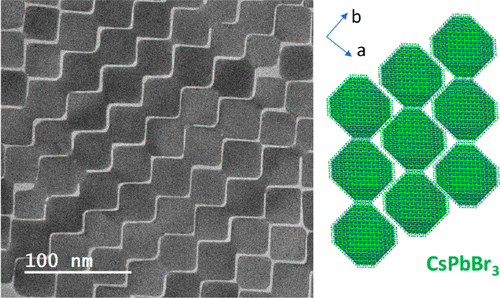当前位置:
X-MOL 学术
›
J. Am. Chem. Soc.
›
论文详情
Our official English website, www.x-mol.net, welcomes your
feedback! (Note: you will need to create a separate account there.)
Facets Directed Connecting Perovskite Nanocrystals
Journal of the American Chemical Society ( IF 14.4 ) Pub Date : 2020-03-24 , DOI: 10.1021/jacs.0c02168 Biswajit Hudait 1 , Sumit Kumar Dutta 1 , Avijit Patra 1 , Diptam Nasipuri 1 , Narayan Pradhan 1
Journal of the American Chemical Society ( IF 14.4 ) Pub Date : 2020-03-24 , DOI: 10.1021/jacs.0c02168 Biswajit Hudait 1 , Sumit Kumar Dutta 1 , Avijit Patra 1 , Diptam Nasipuri 1 , Narayan Pradhan 1
Affiliation

|
Connecting nanocrystals with removal of interface ligand barriers is one of the key steps for efficient carrier transportation in opto-electronic device fabrication. Typically, ion migration for crystal deformation or connection with another nanocrystals needs a solvent as medium. However, in contrary, this has been observed for CsPbBr3 perovskite nanocrystals in film where nanocrystals were swollen to get wider and fused with adjacent nanocrystals in self-assembly on film during solvent evaporation. Depending on precursor composition and exposed facets, again these connections could be programmed for tuning their connecting directions leading to different shapes. Aging further on solid substrate, these were also turned to continuous film of nanostructures eliminating all inter-particles gaps on the film. This transformation could be ceased at any point of time, simply by heating or adding sufficient ligands. Analysis suggested that these unique and controlled connections were only observed with polyhedron shaped nanostructures with certain compositions and not with traditionally cubes. Details of this solid surface transformation during solvent evaporation was analysed and inter-particle material transfer type mechanism was proposed. As these observations were not seen in chalcogenide and oxide nanocrystals, and exclusively observed in perovskite nanocrystals, this would add new fundamentals to the insights of crystal growths of nanocrystals and would also help in obtaining films of connecting nanocrystals.
中文翻译:

晶面定向连接钙钛矿纳米晶体
连接纳米晶体并去除界面配体势垒是光电器件制造中有效载流子传输的关键步骤之一。通常,用于晶体变形或与另一个纳米晶体连接的离子迁移需要溶剂作为介质。然而,相反,这已经在薄膜中的 CsPbBr3 钙钛矿纳米晶体中观察到,其中纳米晶体在溶剂蒸发过程中膨胀变得更宽并与相邻的纳米晶体在膜上自组装融合。根据前体成分和暴露面,这些连接可以再次编程以调整它们的连接方向,导致不同的形状。在固体基材上进一步老化,这些也变成了连续的纳米结构薄膜,消除了薄膜上的所有颗粒间间隙。这种转变可以在任何时间点停止,只需加热或添加足够的配体。分析表明,这些独特且受控的连接仅在具有某些成分的多面体形纳米结构中观察到,而不是在传统的立方体中观察到。分析了溶剂蒸发过程中这种固体表面转变的细节,并提出了颗粒间材料转移类型的机制。由于在硫族化物和氧化物纳米晶体中没有看到这些观察结果,而仅在钙钛矿纳米晶体中观察到,这将为纳米晶体的晶体生长的见解增加新的基础,也将有助于获得连接纳米晶体的薄膜。分析表明,这些独特且受控的连接仅在具有某些成分的多面体形纳米结构中观察到,而不是在传统的立方体中观察到。分析了溶剂蒸发过程中这种固体表面转变的细节,并提出了颗粒间材料转移类型的机制。由于这些观察结果在硫属化物和氧化物纳米晶体中没有看到,而仅在钙钛矿纳米晶体中观察到,这将为纳米晶体晶体生长的见解增加新的基础,也将有助于获得连接纳米晶体的薄膜。分析表明,这些独特且受控的连接仅在具有某些成分的多面体形纳米结构中观察到,而不是在传统的立方体中观察到。分析了溶剂蒸发过程中这种固体表面转变的细节,并提出了颗粒间材料转移类型的机制。由于这些观察结果在硫属化物和氧化物纳米晶体中没有看到,而仅在钙钛矿纳米晶体中观察到,这将为纳米晶体晶体生长的见解增加新的基础,也将有助于获得连接纳米晶体的薄膜。分析了溶剂蒸发过程中这种固体表面转变的细节,并提出了颗粒间材料转移类型的机制。由于这些观察结果在硫属化物和氧化物纳米晶体中没有看到,而仅在钙钛矿纳米晶体中观察到,这将为纳米晶体晶体生长的见解增加新的基础,也将有助于获得连接纳米晶体的薄膜。分析了溶剂蒸发过程中这种固体表面转变的细节,并提出了颗粒间材料转移类型的机制。由于这些观察结果在硫属化物和氧化物纳米晶体中没有看到,而仅在钙钛矿纳米晶体中观察到,这将为纳米晶体晶体生长的见解增加新的基础,也将有助于获得连接纳米晶体的薄膜。
更新日期:2020-03-24
中文翻译:

晶面定向连接钙钛矿纳米晶体
连接纳米晶体并去除界面配体势垒是光电器件制造中有效载流子传输的关键步骤之一。通常,用于晶体变形或与另一个纳米晶体连接的离子迁移需要溶剂作为介质。然而,相反,这已经在薄膜中的 CsPbBr3 钙钛矿纳米晶体中观察到,其中纳米晶体在溶剂蒸发过程中膨胀变得更宽并与相邻的纳米晶体在膜上自组装融合。根据前体成分和暴露面,这些连接可以再次编程以调整它们的连接方向,导致不同的形状。在固体基材上进一步老化,这些也变成了连续的纳米结构薄膜,消除了薄膜上的所有颗粒间间隙。这种转变可以在任何时间点停止,只需加热或添加足够的配体。分析表明,这些独特且受控的连接仅在具有某些成分的多面体形纳米结构中观察到,而不是在传统的立方体中观察到。分析了溶剂蒸发过程中这种固体表面转变的细节,并提出了颗粒间材料转移类型的机制。由于在硫族化物和氧化物纳米晶体中没有看到这些观察结果,而仅在钙钛矿纳米晶体中观察到,这将为纳米晶体的晶体生长的见解增加新的基础,也将有助于获得连接纳米晶体的薄膜。分析表明,这些独特且受控的连接仅在具有某些成分的多面体形纳米结构中观察到,而不是在传统的立方体中观察到。分析了溶剂蒸发过程中这种固体表面转变的细节,并提出了颗粒间材料转移类型的机制。由于这些观察结果在硫属化物和氧化物纳米晶体中没有看到,而仅在钙钛矿纳米晶体中观察到,这将为纳米晶体晶体生长的见解增加新的基础,也将有助于获得连接纳米晶体的薄膜。分析表明,这些独特且受控的连接仅在具有某些成分的多面体形纳米结构中观察到,而不是在传统的立方体中观察到。分析了溶剂蒸发过程中这种固体表面转变的细节,并提出了颗粒间材料转移类型的机制。由于这些观察结果在硫属化物和氧化物纳米晶体中没有看到,而仅在钙钛矿纳米晶体中观察到,这将为纳米晶体晶体生长的见解增加新的基础,也将有助于获得连接纳米晶体的薄膜。分析了溶剂蒸发过程中这种固体表面转变的细节,并提出了颗粒间材料转移类型的机制。由于这些观察结果在硫属化物和氧化物纳米晶体中没有看到,而仅在钙钛矿纳米晶体中观察到,这将为纳米晶体晶体生长的见解增加新的基础,也将有助于获得连接纳米晶体的薄膜。分析了溶剂蒸发过程中这种固体表面转变的细节,并提出了颗粒间材料转移类型的机制。由于这些观察结果在硫属化物和氧化物纳米晶体中没有看到,而仅在钙钛矿纳米晶体中观察到,这将为纳米晶体晶体生长的见解增加新的基础,也将有助于获得连接纳米晶体的薄膜。









































 京公网安备 11010802027423号
京公网安备 11010802027423号